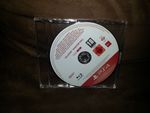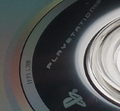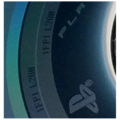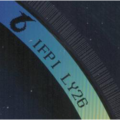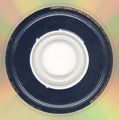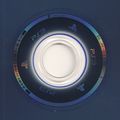Disc Identification/Serialization Data
The Identification & Serialisation Data from a PS4 Game Title contains several Information, which you can find not only on any Game Disc pressed for the PS4, but also similar for any PS3 or any other Console-based Disc Game and other Media pressed on CD, DVD and Blu-ray.
Title ID Spine Code
The Title ID (there is no official name about this numeric coding from Sony) defines a internal numeric coding system and can be compared to a part/catalogue number or a ISBN number for a book. With this code, which every Game contains, it is possible to identify every Game whichever released. Sony used already this system for releasing their Games on PlayStation, PlayStation 2 and PlayStation 3, both for disc-based games and for their digital pendants, released in the PlayStation Store.
While Sony used different codes for different region areas in Japan, North America, Europe, Hong Kong and Asia for their games released on PlayStation, PlayStation 2 and PlayStation 3, it seems that there were no regional differences on games released for the PlayStation 4 in general, but every game use another code compared to the same game released in another region. Also it seems that there are no differences from Games released directly from Sony Computer Entertainment (First Party) or from Third party developers (Licensed). And for this time, Games released for the PS4 shares the same code both on the pressed disc game version and for the digital version released in the PlayStation Store.
You can find these codes on several positions for example printed in the spine from a Game cover & on the top of the pressed Disc but also located in the PARAM.SFO & probably used as a folder structure for Games installed on the Harddrive.
Examples
- Games released for the PlayStation 4 contains a numeric coding system in the format "CUSA-XXXXX" (while the "XXXXX" contains a 5-digit-code for every released game).
- For the regional differences, every game shares the same "CUSA-XXXXX" format, but for example the European Version from the Launch Title "Killzone: Shadow Fall" are listed with the "CUSA-00002" code, while the North American version from the same game are listed with the "CUSA-00190" code.
- About the difference between First party released Games or Licensed ones, Games released directly from Sony Computer Entertainment (SCE) for the PlayStation (2) are listed in the "SCES-XXXXX" format, while directly released Games from Sony for the PlayStation 3 are listed with the "BCES-XXXXX" code (in this example from Sony Computer Entertainment Europe (SCEE)). Other Third party Games are listed with "SLES-XXXXX" (for PlayStation (2)) and with "BLES-XXXXX" (for PlayStation 3).
- But it seems that all Games released for the PlayStation 4 will use the same "CUSA-XXXXX" format (Killzone: Shadow Fall, European Version = "CUSA-00002" & FIFA 14, European Version = "CUSA-00128"), while the European Version from Killzone 3, released for the PlayStation 3 are listed in the BCES-01007 instead of a BLES-XXXXX format).
- Games released both on disc and in the PlayStation Store shares the same Title ID (European PSN-Versions from Killzone: Shadow Fall = "EP9000-CUSA00002_00-KZ4RELEASE000041" and FIFA 14 = "EP0006-CUSA00128_00-FIFAFOOTBALL2014").
Notes
There is a good overview in the PS3 Section about the Title ID where you can imagine how easy the new numeric coding system works on the PS4 now.
It is also unknown if Game Saves from a disc-based Game works also for the PSN version.
Source Identification Code
The Source Identification Code (SID-Code) can be found on almost all pressed optical discs worldwide since 1994, originally planned as a piracy safeguard, but it's also used as a quality control measure. It contains two Codes, one Mould Code and one Mastering Code (hidden on PlayStation 4 Game Discs with multiple PS4 logos). Each Code consists the digits "IFPI" (named by the International Federation of the Phonographic Industry) followed by a four or (less often) five digit code (commencing with the letter "L"). These two codes can be used to trace the location from a manufacturing or mastering plant where the disc got pressed. The Mastering Code is located in the inner surface from any optical Disc, outside the data section.
Mastering plant SID Codes
| Region (Suffix) | SID-Mould code | SID-Mastering code(s) | Mastering plant | Country | Disk type | Remark |
|---|---|---|---|---|---|---|
| Europe (04) | IFPI 94** | IFPI L551 to IFPI L560 | Sony DADC Austria AG | PSX/PS3/PS4? | Thalgau, near Salzburg | |
| Europe (04) | IFPI LY** | IFPI LZ08 | QOL Fi Group | PS4 | IFPI LY25 = CUSA-00002 (Killzone: Shadow Fall) & IFPI LY26 = CUSA-00128 (FIFA 14) | |
| Europe (04) | IFPI L5** | ? (hidden with multiple PS2 logos) | Sony DADC Austria AG | PS2 | Anif, near Salzburg |
Gallery
References
Burst cutting area
The (narrow) burst cutting area ((N)BCA) can be used for adding additional information such as serial numbers or any information about the manufacturing process etc. The BCA-code is written using a Nd:YAG laser and can be also used as a security measure to avoid illegal copies from a pressed disc (for example on game discs for the Nintendo GameCube, Wii & Wii U). Therefore it isn't possible to reproduce/copy the BCA with a standard optical disc drive running on a PC/Laptop.
- Location: inner surface, inside data section
- Radius: 1.2 mm (zone between 22.3 ±0.4 mm to 23.5 mm ±0.5 mm (single-layer), 21.0 ±0.4 mm to 22.2 mm ±0.5 mm (dual-layer))
- Data size: 12 bytes (minimum) to 188 bytes (maximum) (in steps of 16 bytes)
Sometimes blank recordable & rewritable discs (such as DVD-R/RW/RAM) uses also a BCA-code were information about the CPRM and other DRM-policies were stored.
On Blu-ray discs a Pre-recorded Media Serial Number (PMSN) can be stored in the BCA (but extremely unlikely on PS3/PS4 game discs because this was a part from the AACS copy protection).
PIC Zone
This (pre-recorded) PIC zone, which is included within the BCA (Data size: 0x73 bytes), contains general information about the disc that includes, but is not restricted to:
- Physical media class and version,
- Physical address of the start of the Data Zone
- Physical address of the start of the outer zone (if this is a single layer media, this is the lead-out)
- Number of layers
- Recording Density
- Write power information
Gallery
- DVD showing CBA in detail - on the inner surface is the IFPI.jpg
DVD showing CBA in detail - on the inner surface is the IFPI
- Wii Disk showing CBA in detail - on the inner surface is the IFPI.jpg
Wii Disk showing CBA in detail - on the inner surface is the IFPI
References
- Standard ECMA-267 - 3rd Edition - April 2001
- Physical Format Specifications for BD-ROM White Paper - 6th Edition - October, 2010
- Advanced Access Content System (AACS): Blu-ray Disc Pre-recorded Book
Angular Marks
Angular Marks are also a security measure to avoid piracy. It works similar to the BCA but with the difference that these Marks were located in the data area of a disc/outside the BCA.
It can be compared to the old Bad Sector copy protection, were the CD-ROM got pressed with zero-filled Physical Sector Numbers, which are unreadable for some writers without RAW writing function.
It is known that Sony (Pictures Entertainment) use these Marks to avoid illegal copies on Blu-ray Movies (which is easy to bypass), but there are no information about the application on PS3/PS4 game discs pressed on BD-ROM.
References
ROM Mark
Notes
It is unknown if any PS3/PS4 game discs contains any ROM Mark because these Marks are only in use when there are several Mastering plants who got the order to press identical DVD's and/or Blu-ray's (for example when one plant in Portugal and another one in Finland has the orders to press the same Blu-ray Movie with the same Languages and Subtitles for releasing in several European markets. Therefore it is like a copy protection between all Mastering plants and those are able to verify if there is some other (unlicensed) Mastering plant who reproduce a DVD and/or Blu-ray without permission, like on some Third World markets with illegal copies in China and so on). But it seems that there are only one Mastering plant for each Region who got the license to press PS4 Game Discs. As like, it would be redundant that PS4 Game Discs contains ROM Marks.
So the ROM Mark can be also used as a security measure against piracy, which works together with AACS. Of course it is possible that the ROM Mark could be able to communicate with any other file(s) on a PS3/PS4 Game Disc, but with which one (EBOOT.BIN)?
Therefore the following can be thought of as a general Information.
Information
ROM Mark or BD-ROM Mark is a serialization technology designed to make it more difficult for replication plants to do unlogged over-runs (being sold out the back door, without the copyright holder's knowledge) on a pressing.
Only licensed BD-ROM manufacturers have access to the equipment that can make these unique ROM Marks (physical-layer to store key cryptographic secrets).
Although every machine used to laser-cut a master disc is theoretically the same, the motor that spins the blank disc and moves the laser along a spiral track varies slightly in speed and precision. So if a digital marker is put in the middle of a recording, its physical position on the master disc - and every disc then pressed - will be a unique fingerprint of the cutting machine.
- location:
- length:
- sample:
Patents and references
- http://www.google.com/#q=rom+mark+patent
- Blu-ray and HD DVD Content Protection
- Blu-ray Disc Marking System Explained
- Blu-Ray Disc Copy Protection - Whitepaper October 2006
Trivia
If you got horny about the pictures of the bottom side of a PS4 Game Disk:
- CUSA-00002 (Killzone: Shadow Fall) JPG @ 8072x8192px TIF @ 11758x11933px
- CUSA-00128 (FIFA 14) JPG @ 5664x5712px TIF @ 5664x5712px
Generic
- Postscribed ID
- http://www.blu-raydisc.com/assets/downloadablefile/bd-romwhitepaper20070308-15270.pdf (including page 40 SID, page 41 BCA, page 45 PIC Zone)
- AACS specifications
- Patent 07278031 - Secure distribution of portable game software & img
- Thomson Patent:
- Optical disc with pre-recorded and recordable regions (A proposed alternative for CBA: disabled at factory, enabled at a point of sale)
| |||||||||||||||||||||||||||||||||||||
